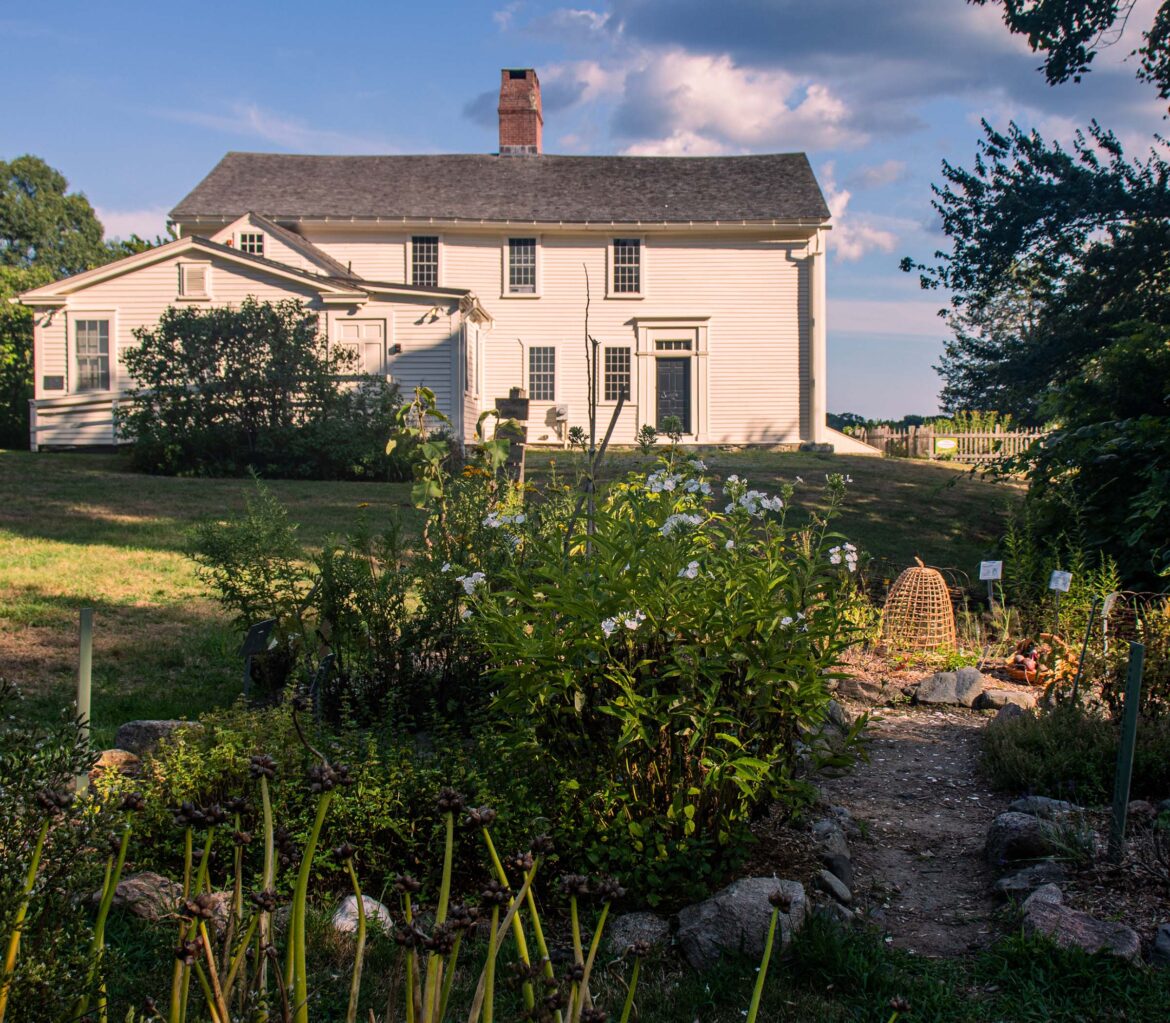KINGSTON, R.I. – Nov. 21, 2025 – As Rhode Islanders head to dining tables this month to celebrate the year’s ceremonial harvest, local Cooperative Extension Master Gardeners say that community gardens offer understanding of state history, not only for Thanksgiving, but also as the state heads toward next year’s 250th anniversary of the signing of the Declaration of Independence.
This July, the historic gardens at Smith’s Castle in North Kingstown, operated by the Cocumscussoc Association, joined URI Master Gardeners’ “Gardening with the Masters” tour and offered other tours as well.
Nestled among cattails, Cocumscussoc is part of the ancestral homeland of the Narragansett People. Smith’s Castle, built in 1678, is the oldest surviving plantation house in America and the gardens found there demonstrate practices followed by early gardeners which can still be applied today; the site has been designated a National Historic Landmark.
 Local community gardens offer understanding of ways that people lived in Rhode Island in the past. (URI Photo / Cooperative Extension)
Local community gardens offer understanding of ways that people lived in Rhode Island in the past. (URI Photo / Cooperative Extension)
Built in 1678, Smith’s Castle is one of the longest standing Master Gardener partnerships in the state and offers perspective on the food found on New England tables in the 1600s. Ann Casey ’69, a trustee of Smith’s Castle, and a URI Master Gardener ’04, says that the Smith’s Castle gardens give visitors an expanded sense of Rhode Island history, and demonstrate the importance of the land in this area.
“The Narragansett had their summer encampments here,” says Casey. “They farmed, fished, hunted and foraged, providing their people with a bountiful food supply, medicinal remedies, tools, weapons, shelter material and more.”
URI Master Gardeners have restored and continue to tend the site’s historic gardens in an effort to help educate visitors about Rhode Island history.
“Our Master Gardeners use the gardens to educate visitors about practices of these historic gardeners which are still very valid,” says Casey. “Many of these practices also illustrate modern science-backed methods which benefit both gardeners and the environment.”
 Cooperative Extension Master Gardeners at Smith’s Castle maintain gardens that reflect changing styles over time, demonstrating how gardens can be both beautiful and beneficial. (Photo Ann Casey)
Cooperative Extension Master Gardeners at Smith’s Castle maintain gardens that reflect changing styles over time, demonstrating how gardens can be both beautiful and beneficial. (Photo Ann Casey)
At today’s Smith’s Castle, visitors can see the Three Sisters Garden which showcases a planting scheme used by many Indigenous tribes: “Corn, beans and squash are planted together in a great example of biodiversity,” says Casey. “All three plants benefit from each other, increasing yields for a healthy diet, and providing long-term soil fertility. The three vegetables complement each other nutritionally and, cooked together with meat, provide a completely balanced diet.”
She notes there is much that contemporary gardeners can learn from Indigenous gardeners, such as mounding soil rather than tilling it to avoid erosion and maintain healthy soil, companion planting, seed saving, and observing nature for signs when to plant.
The castle also includes an early colonial herb garden, which was both farm and pharmacy for all who lived on the property at that time, and a Georgian-style garden reflecting the increasing wealth and status of the family.
“Early colonists needed to be very self-sufficient,” Casey comments. “The housewife, in particular, was responsible for growing many of the plants needed to feed her family, minister to any illness, and provide household necessities. She learned about beneficial native plants, growing them in the vegetable garden just outside the kitchen for her family, and also the larger community. Even the Georgian garden would include the necessary plants as well as those planted just for their beauty”.
Colonial gardening practices that can be followed and implemented today include:
Planting in raised beds. Soil warms faster and drains better. Access to all sides of the bed keeps soil from being compacted.
Feeding your soil. Use plenty of compost when preparing beds and at the end of the season.
Planting a variety of plants in each bed. Diversity will bring in many pollinators and reduce the chances of disease destroying a whole crop.
Planting intensely. Weeds will have little space to take hold. Shaded soil will also stay cooler.
“Many of the historic plants in these gardens reflect local Indigenous history and connect to ecological practices today,” says Vanessa Venturini, program leader with URI Cooperative Extension. “We have a number of historical gardens we partner with, many of which contain colonial plants and Indigenous teachings reflecting the history of this area prior to colonization.”
Master Gardeners support gardens at other historical sites in Rhode Island:
Glocester Heritage Society, Dr. Reuben Mason House Medicinal Garden, Chepachet
Glocester Heritage Society, Job Armstrong Shopkeeper’s Garden, Chepachet
Slater Mill Pollinator Garden, Blackstone River Valley National Historical Park, Pawtucket
Pettaquamscutt Community Garden at Canonchet Farm, Narragansett
John Hunt House Heritage Gardens, East Providence
Three Master Gardener sites are now part of the program’s alumni network: the Historic Varnum House Preservation Gardens in East Greenwich, Prescott Farm in Middletown, and the Mount Hope Farm in Bristol. URI’s Cooperative Extension program has also built its partnership with Indigenous organizations. The URI Master Gardener core training now includes a focus on Indigenous plants and Traditional Ecological Knowledge.
To learn more about traditional plants to grow in Rhode Island, contact the URI Master Gardener Program gardening and environmental hotline (401-874-4836 / gardener@uri.edu). To get on the Cooperative Extension email list for future programs, or to learn more about URI’s Home Horticulture Certificate starting in January, email coopext@uri.edu or call (401) 874 -2900. Learn more at https://web.uri.edu/coopext/.


Comments are closed.